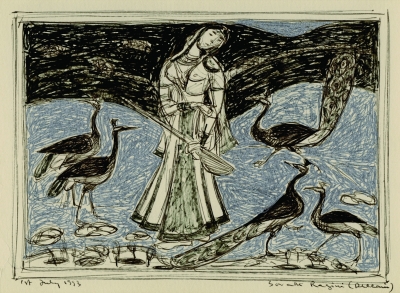Drawings are my conversational language
By IANS | Published: August 19, 2021 07:57 AM2021-08-19T07:57:03+5:302021-08-19T08:35:16+5:30
New Delhi, Aug 19 He has been sketching and drawing all his life, picking up notes from around ...

Drawings are my conversational language
New Delhi, Aug 19 He has been sketching and drawing all his life, picking up notes from around him, working and re- working on these forms to integrate them into his personal style and using them as his reference points for paintings and sculptures.
From the large body of A. Ramachandran drawings and sketches, Vadehra Art Gallery in the capital selected works from 1965 to the present day for the exhibition ‘A Lifetime of Lines'. "They are testimonies of how I think, talk to myself and express different emotions according to different subjects. I consider my drawings as my conversational language and not the more restrained and disciplined language of my paintings and sculptures," said major contemporary artist A. Ramachandran.
Recipient of the Padma Bhushan honour, Ramachandran, who started his career with realism, which reflected the angst of urban life, but shifted to myths in the 80's admits, "While in my early days, I was influenced by the Mexican artists whose works I felt were closer to ours than other European artists, there was also a realisation that myth was a part of collective consciousness of the people which could be effectively used to interpret one's world without imitating any artist. My ‘Yayati', the monumental work I did for Ebrahim Alkazi is one of the finest examples of that," said the artist who did his doctoral thesis on Kerala mural painting.
Stressing that his education at Santiniketan has been instrumental in shaping him in multiple ways, and ‘A Lifetime of Lines' is a testimony to that, the artist, who designed the granite bas-relief sculpture at the Rajiv Gandhi Memorial at Sriperumbudur, near Chennai which extends for 125 feet and has a height of nearly 20 feet remembers that right from the first year, students are asked to go out and study from nature and the sketching process is much different from western traditions.
"Nandalal developed a concept of structural drawings. Benode Behari and Ramkinkar developed that further. Unlike in the western tradition, students at Santiniketan are encouraged to look at the structure of an object rather than the externals. Everything in nature is in fact based on this principle. From the main stem, the number of veins that spread out decides the shape of the leaf. It can be one central vein which makes an oval shape or three veins of a leaf bifurcate like a leaf of a cotton plant. In short, the external shape depends on the structure of the vein of the leaf. Same is with the human body. The skeletal system determines the shape of human beings, animals or birds. These understandings give you a complete knowledge of structure rather than the external skin surface. This is the most important lesson I learnt from Santiniketan which I use as the grammar of my art practice."
For someone who completed his Master's degree in Malayalam and also studied classical Carnatic music from the age of five to sixteen, Ramachandran, who has also written and illustrated numerous picture books for children published in India, Japan, Britain and the United States feels the evolution of the language from neo- classical to modern literature gave him an indication how Indian art could also develop from the grass root level to become an authentic language of our time instead of just borrowing from Europe. "Similarly, music must have given me an inherent rhythm and pattern to enrich my pictorial language," feels the artist, a major retrospective of whose work was organised by the National Gallery of Modern Art
Disclaimer: This post has been auto-published from an agency feed without any modifications to the text and has not been reviewed by an editor
Open in app